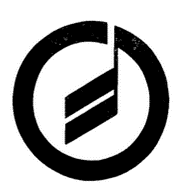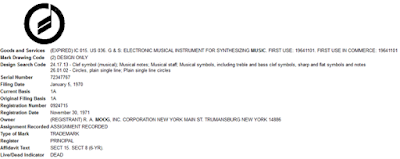How much do you know about synthesizers or theremins? If you're an electronic music fan, or a modern musician, chances are you've at least heard about them, and likely the name Moog. And if you do, chances also are you've seen news about Moog Music.
Robert (Bob) Moog (pronounced MOHG) was one of the greatest American synthesizer and theremin designers and engineers. He invented what amounted to the first commercial synthesizer, the eponymous "Moog Synthesizer" in 1964. In 1970, he created a portable version, the "Minimoog". And while working towards his PhD in engineering physics at Cornell (earned 1965), he designed multiple theremins.
 |
| Moog's symbol, used since 1964 |
Despite his ingenuity in designing electronic musical equipment, Moog was never a savvy businessman. He founded his original company, R.A. Moog Co., in 1953. It was a small start-up that sold mail-order self-assembled theremin kits. It mostly funded his education in the beginning, but later grew in size and produced Moog synthesizers.
 |
| TESS information on the Moog symbol, first registered by R. A. Moog, Inc. |
 |
| Diagram image from US patent 3,475,623 for the high-pass filter function |
 |
| US Patent 4,050,343 Electronic Music Synthesizer, one of Moog's most important Norlin inventions |
Moog Music and Norlin declared bankruptcy in 1987. But the Moog trademark did return to Bob Moog. Another entity purchased its rights when the registration expired in 1994; Don Martin owned Moog's eponymous trademark.
While the 1980s saw a decline in popularity of analog synthesizers characteristic of Moog Music equipment (like the Minimoog), the trademark and its associated inventor never completely diminished. Moog continued to be an important name in the electronic music industry across the decades.
 |
| Moog Music, Inc. trademark, reg. no. 2473815 |
In 2000, a legal battle over Moog Music and associated trademarks ensued, with Moog working to regain the rights. Therefore, it was a triumph for Dr. Moog when he finally won the case and ownership of Moog Music in 2002.
Big Briar, of Asheville, NC was dropped and Moog Music reinstated. A resurgence in popularity of analog synthesizers, starting in the 2000s, meant the business had a real market. Bob Moog returned to creating new products. The Moogerfooger of Big Briar was accompanied by the Minimoog Voyager and more.
 |
| A specimen image of a Moogerfooger, provided for the trademark registration (no. 2379940) |
Yet the IP story of Moog Music hardly ends there. After Bob Moog's death, his business partner took over, and shifted about 40% of the shares in the company to its employees, creating a largely employee-controlled business in 2015. This became a core part of the Moog Music reputation and brand identity.
 |
| Figure from US Patent 10,229,664 Voltage Controlled Oscillator with Variable Core for Electronic Musical Instrument and Related Methods, Moog Music's last |
As mentioned above, electronic music equipment engineers and creators evidently are not known for business savvy (this trajectory of losing control of a business is just one; see Dave Smith of Sequential Circuits or Alan R. Pearlman of ARP). Moog Music survived the employee-directed format for less than a decade.
Here we reach the part of the tale that has demanded recent news attention. Moog Music has once again been sold to another company. It almost certainly will not be employee-controlled, as they have little ownership in the current circumstances. And it's hard to say what the future will be for one of the most famous names and brands in electronic music.
inMusic, the new owner, is a conglomerate and holds multiple music brands already. Their website is simply a list of those (Moog not yet included). It is probably accurate to assume that Bob Moog would not have been in favor of this arrangement; yet it is undeniable it follows a similar pattern from his lifetime.
Resources:
https://moogfoundation.org
https://en.wikipedia.org/wiki/Moog_Music
No comments:
Post a Comment